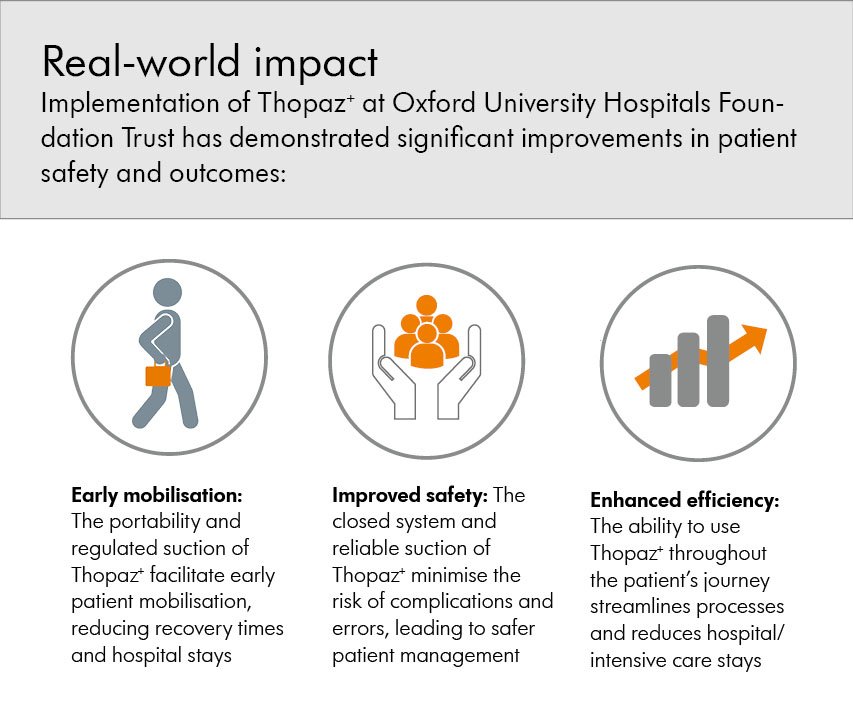Indsigter om pleuradrænage
Tid til at læse: 1 min.
Click here to download the complete report.
Thopaz+ is a portable digital chest drainage and monitoring system developed by Medela. Thopaz+ offers continuous objective monitoring of air leaks and fluid output, which facilitates assessment of patients' progress, as well as standardisation of chest drainage management across different departments.
The Thopaz drainage system was introduced to the Cardiothoracic Department at Oxford University Hospitals Foundation Trust in the UK in 2012, followed later by the Thopaz+ digital drainage system. The positive experience in this department led to further spread of Thopaz+ into respiratory, critical care, trauma, gastroenterology, paediatrics and neurosciences – driven by clinicians and nursing staff. Interviews with healthcare professionals from Oxford about their experiences with this device highlight how it has improved patient safety.
Click here to download the 2-page summary of the report.
Traditional underwater seal drains come with several significant challenges that impact patient safety and mobility:

Clinicians at Oxford described ambulation as a key benefit of Thopaz+. Early mobilisation of patients following surgery reduces the risk of postoperative complications, hospital stays and recovery times. However, underwater seal drains that require wall suction restrict patients’ movement, so they may be discouraged from mobilising because of the nurse support needed to detach and reattach a drain to a wall suction unit and accompany a patient. In contrast, the portability of Thopaz+, which provides its own regulated suction and does not need to be positioned below chest level, means that nursing support is not needed for patients to move around.
It makes patients mobile quicker, so their risk of developing other complications of being in bed is reduced.
Interviewed clinicians highlighted that because Thopaz+ is a closed, dry system, the potential for incidents, errors, accidental mishaps, and infections is reduced. As Thopaz+ provides its own controlled suction source, it avoids complications with wall suction used with underwater seal drains – such as suction becoming displaced or unclipped from the wall, the level of suction being set too strong, blockages if filters get wet, and unreliability of poorly maintained wall suction.
Clinicians valued the fact that Thopaz+ can be used throughout a patient’s journey, because whenever a device is changed, the tubing can become kinked or displaced. Postoperatively, most patients are fitted with Thopaz+ in theatre and transferred straight to the ward, avoiding the need for a stay in the intensive care unit. The importance of Thopaz+ is underscored by the fact that all patients fitted with an underwater seal drain arriving in the trauma unit are switched to Thopaz+ due to the recognised complexities and safety implications of managing patients with an underwater seal drain.
The real-world experience with Thopaz+ in this leading UK hospital offers insight into how this technology facilitates earlier mobilisation of patients and improves patient safety, ultimately leading to better patient outcomes and benefits for the local healthcare system.

Safety and efficiency [are] the two [main differences] for the patient journey between underwater seal drains and digital systems such as Thopaz+.
Thopaz+ is transforming chest drainage management, providing a safer and more efficient solution that addresses the limitations of traditional methods and enhances overall patient care.
Artikler, der kan have interesse